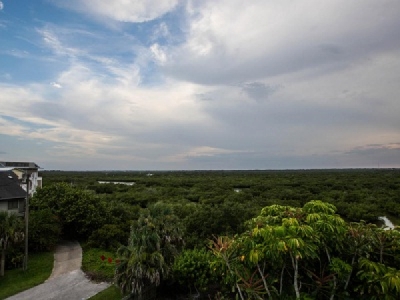
Posted on August 8, 2016
By Dinah Voyles Pulver, News-Journal
Amidst community concern, the U.S. Army Corps of Engineers has extended its public comment period for a proposed wetland mitigation bank in New Smyrna Beach.
The federal agency, which would jointly permit the proposed 315-acre Webster Creek Mitigation Bank with the St. Johns River Water Management District, extended the deadline for comments to August 24.
Residents who live near the bank or often use the surrounding Mosquito Lagoon Aquatic Preserve have raised questions and are trying to convince the Corps to conduct a local public hearing. The group has picked up some key supporters and also, as of Wednesday, had gathered 374 signatures on an online petition seeking the hearing.
The wetland restoration and mitigation bank is proposed on property owned by Davey Johnson, former Major League Baseball All-Star player and manager, between the Intracoastal Waterway and Bethune Beach.
Opponents, including residents whose homes border Johnson’s property, fear losing access to waterways near their homes and possibly harmful environmental impacts from the flattening of old spoil piles and filling in of ditches dug in the 1950s for mosquito control.
They also question whether the project is a conflict of interest for John Miklos, president of Bio-Tech Consulting, the Orlando company Johnson hired to help get the bank permitted by the water district and the Corps. Miklos is serving a rare third term as chairman of the water district’s governing board.
One key issue is how much of the land within the proposed bank Johnson owns and how much is state-owned sovereign land. Volusia County property records show Johnson owns about 152 acres. To work out the details of the mean high water line, which determines property ownership, Miklos corresponded directly with the Department of Environmental Protection. State and district officials have stated they’re investigating the ownership question.
The property is crisscrossed with ditches dug into salt marshes in the 1950s for mosquito control. Johnson proposes to level the spoil piles by using pressurized water to blast the dirt back into the ditches, creating a more natural water flow in the marshes and mangrove islands. He insists the project is a good thing, returning the land to its natural state.
In exchange for the restoration, Johnson would be granted credits by the water district and the Corps that he would in turn sell to developers who need to buy credits when they destroy wetlands during construction projects. The number of credits he receives will be based on how much land he actually owns and restores. The going rate for credits in coastal wetlands is more than $135,000 per acre.
In a cooperative partnership with Volusia County, NOAA and the water district, mosquito ditch restorations have been underway for years in the area, including some on the property Johnson included in the mitigation bank prospectus. The restorations have been highly controversial and the outcome of a lawsuit over the restoration work is pending.
Fishermen and shellfish farmers have alleged undoing the ditches releases too much silt, destroys habitat and releases old pollutants such as DDT stored in the muck and spoil areas.
That’s an argument also being used by the bank opponents, who argue the proposed hydroblasting could be even more harmful, a charge that Bio-Tech disputes in a news release it issued last week.
In the July 27 release, Bio-Tech stated the company had been selected to assist with the proposed restoration and enhancement project. The firm stated the bank aims to restore the “historic system” for the benefit of the regional environment.
“The ditching process reduced the overall natural functions provided by these wetlands and negatively impacted important fisheries components, water quality and many other functions,” Miklos stated in the news release. “This restoration project will improve the area’s functionality and greatly benefit the regional environment of Webster Creek as a whole.”
The company stated hydroblasting is “a more environmentally-sensitive technique than the use of heavy earth-moving machines such as bulldozers.”
But the opponents, who are sending letters and scholarly papers supporting their arguments to the Corps, disagree. They picked up the support this week of Mitchell Roffer, president of Roffer’s Ocean Fishing Forecasting Service and a member of the adjunct faculty at Florida Institute of Technology.
Roffer sent a two-page letter to the Corps opposing the restoration. He disputed the assertions in the bank prospectus that the area is in a negative state and also the proposed use of ditch blocks to slow water velocity. The proposed use of herbicides to control nuisance and aquatic plants will further degrade the ecosystem, he stated, and are likely to kill or impair developing fish larvae.
Also adding his opposition is Tom Lee, an emeritus professor of oceanography at the Rosentiel School of Marine and Atmospheric Science at the University of Miami, who lives on the edge of the proposed bank.
“I know from experience that the most important property of healthy marine mangrove and salt marsh habitats is water renewal by tidal exchange,” Lee stated in an email to The News-Journal. “Speaking as a scientist that has been all over the Preserve for the last 24 years, I can see no degradation of water quality. Instead I see a healthy, diverse ecosystem responding to the rapid exchange of creek and canal waters by tidal exchange.”
Lee added that “water blasting spoil mounds into small creeks and canals will cause a significant reduction and even a loss of tidal exchange to large areas of the mitigation bank, including home waterfronts where stagnation will set in.”
Questions, comments or concerns must be submitted to Amy Thompson, U.S. Army Corps of Engineers by July 24.
Amy.D.Thompson@usace.army.mil
904-232-3974
Jacksonville District Corps of Engineers, P.O. Box 4970, Jacksonville, Florida 32232-0019
Source: News-journal





